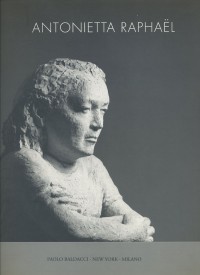Saggio di Emily Broun
Estratto
(...) Raphael exploited thr concept of the partial or the broken and adapted figure to evolve a formal language consonant with the experience of the femaal body, and hence at odds with the idealism of the classic tradition. Genesi 1 (1947) her first version of the pregnant form, is headless, emphasizing the sheer weight and sinking posture of the figure. The swollen breasts and limbs address the actual biological functions of pregnancy whyle asserting a proud mass of flesh. She sculpured maternity from the inside out - from an awareness of her own bodily experience - and in doing so, broke with age-old conventions of chaste madonnas or earthy matriarchs.
(...)
The self-adulating figures, viewed in the privacy of thei toilette, allude to the social pressures brought to bear on women to be beautiful and seductive. (...) On the other hand, Raphael's nudes betray her ambition to paint one of the most ubiquitous and prestigious subjects in the history of western art. (...) Yet there is also an identification between viewing subject and painted object, since the female viewer inevitably reflects upon herself in a reciprocal position. The additional presence of another women in the picture - the one who combs her hair, reinforces the sence of complicity. The image of the woman is not that of the ofthe "other" but of kind: clearly Raphael was evaluating the schisms between her sense of self, her sexuality, and the socially constructed feminine archetype.

